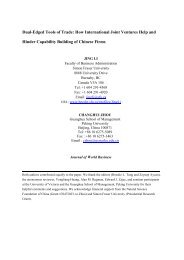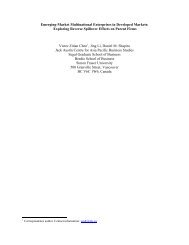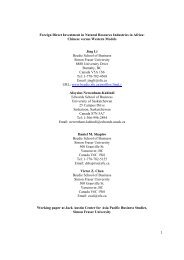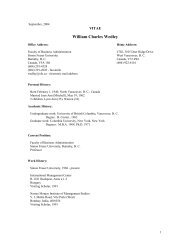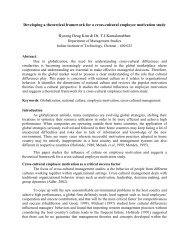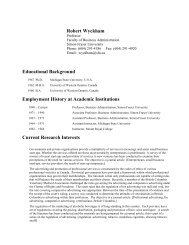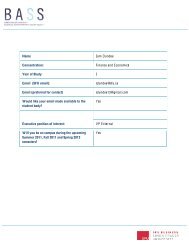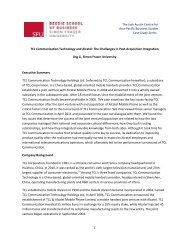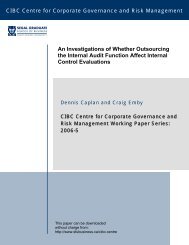1 The Jack Austin Centre For - Beedie School of Business - Simon ...
1 The Jack Austin Centre For - Beedie School of Business - Simon ...
1 The Jack Austin Centre For - Beedie School of Business - Simon ...
Create successful ePaper yourself
Turn your PDF publications into a flip-book with our unique Google optimized e-Paper software.
Executive Summary<br />
Beijing Auto’s Acquisition <strong>of</strong> Saab Automobile’s Technologies<br />
Jing Li, <strong>Simon</strong> Fraser University<br />
1<br />
<strong>The</strong> <strong>Jack</strong> <strong>Austin</strong> <strong>Centre</strong> for<br />
Asia-Pacific <strong>Business</strong> Studies<br />
Case Study Series<br />
In 2009, Beijing Automotive Industry Holding Co Ltd (BAIC), a state-owned holding company, acquired<br />
intellectual property rights and production equipment from Saab Automobile, a Swedish carmaker<br />
owned by General Motors (GM) that had fallen to hard times. To understand the motive and process <strong>of</strong><br />
the acquisition, we interviewed two senior managers in BAIC in March 2011. We found that although<br />
BAIC was <strong>of</strong>fered ownership <strong>of</strong> Saab’s entire operations, BAIC decided to purchase only the technology<br />
that they needed in order to achieve their goal <strong>of</strong> creating their own brands. BAIC learned from the<br />
mistakes made by previous Chinese acquisitions and pushed for technology acquisitions rather than<br />
operations acquisitions with Saab. <strong>The</strong> success <strong>of</strong> the acquisition, for the most part, was credited to<br />
several members <strong>of</strong> the purchasing team who had prior experience working internationally for Western<br />
automobile companies. <strong>The</strong>y played a key role in identifying the technologies required for BAIC to reach<br />
its goal <strong>of</strong> developing its proprietary car.<br />
Company Background<br />
BAIC<br />
BAIC is a state-owned enterprise and holding company <strong>of</strong> several Chinese automobile and machine<br />
manufacturers. <strong>The</strong> companies are sometimes referred to collectively as the Beijing Automotive Group.<br />
BAIC’s lineage can be traced back to 1958 when the First Accessory Factory was renamed to Beijing<br />
Automobile Works during the planned economy era. In the wake <strong>of</strong> the Chinese economic reform, BAIC<br />
was formed as a modern company after a series <strong>of</strong> mergers and corporate restructuring, and now it is<br />
the fifth-largest domestic Chinese automaker. [1]<br />
BAIC’s main subsidiaries include Beijing Automobile Works, producing light <strong>of</strong>f-road vehicles and trucks,<br />
and Beiqi Foton Motor, making trucks and agricultural machinery. Foton Motor is a listed company and<br />
has R&D branches in Japan, Germany, Taiwan and the Philippines. Furthermore, Foton plans to build<br />
several assembly plants in Russia, Mexico, India, Brazil, and Thailand, in order to answer the growing<br />
demand <strong>of</strong> emerging markets for light commercial vehicles. [2]<br />
BAIC currently has several joint ventures with Daimler-Benz AG and Hyundai, which makes Hyundai and<br />
Mercedes-branded autos for sale in the Chinese market. Beijing Hyundai, an equally owned joint<br />
venture with Korean Hyundai Motors, was established in 2002 [3] . Beijing Hyundai, once a latecomer to<br />
the Chinese market, sold 703,000 vehicles in 2011 [4] , which had surpassed those in the Hyundai auto’s
home market. This stunning performance owes its success to Beijing Hyundai's design strategy with a<br />
focus on small, fuel-efficient cars [5] . Ranked as the seventh most-productive Chinese automaker, Beijing<br />
Hyundai is about to introduce new models, including a new brand designed specifically for the Chinese<br />
market.<br />
Daimler AG makes Mercedes-Benz models and trucks with Beijing Auto Group, and has two joint<br />
ventures with the company. Foton and Daimler AG formed a joint venture in July 2010, that is, the<br />
Beijing Foton Daimler Automobile Co Ltd, which makes commercial trucks. [6] <strong>The</strong> second venture Beijing<br />
Benz was established in 2005. While this joint venture assembles and manufactures the Mercedes-Benz<br />
E-Class and C-Class, it does not produce all the Mercedes-branded autos sold in the Chinese market.<br />
Certain models still enjoy a reputation for high quality and luxury and so remain exclusively Mercedes-<br />
Benz imports. Its sales in 2010 exceeded 50,000 units, representing an 80% improvement from the prior<br />
year.<br />
BAIC more than doubled its annual production in three years to 1.5 million vehicles in 2010, while pr<strong>of</strong>its<br />
increased about 700%. With revenues at RMB160 billion, BAIC became the largest and most pr<strong>of</strong>itable<br />
company in Beijing.<br />
Saab Automobile<br />
Saab Automobile is a Swedish-based carmaker that was founded in 1937 originally as the automobile<br />
manufacturing division <strong>of</strong> Swedish Airplane Limited. In 1947 Saab Automobile was separated from the<br />
parent firm. With its origins in airplane manufacturing, safety is a high priority in the design <strong>of</strong> Saab cars.<br />
Saab now is active in more than 50 countries worldwide and the most important markets are the USA,<br />
the UK, Sweden, Germany, Italy, Australia, France, the Netherlands and Norway. [7]<br />
After acquiring Saab in 1990, GM sold Saab to the current owner Dutch high-end car manufacturer<br />
Spyker Cars NV in 2010 because GM was heavily affected by the automotive industry crisis from 2008 to<br />
2010 and needed to reorganize its brand portfolio. During this time, Saab's total world production<br />
plummeted from 125,397 in 2007 to 32,048 vehicles in 2010.<br />
Beijing Auto's Acquisition <strong>of</strong> Saab's Technologies<br />
After several unsuccessful attempts to buy struggling European automakers, such as Opel, as well as to<br />
buy technology from the American Chrysler, [8] Beijing Auto noticed an opportunity for acquisition from<br />
Saab Automobile.<br />
GM announced that the Saab brand was "under review" in December 2008, a process which included<br />
the possibility <strong>of</strong> selling or shutting down the carmaker. When GM’s support receded, Saab slid toward<br />
bankruptcy, and the Swedish government turned down the bailout requests from both GM and Saab. On<br />
16 June 2009, serious talks started with the most prospective bidders, Koenigsegg, which was backed by<br />
a group <strong>of</strong> Norwegian investors, and the BAIC. In the following months, the talks progressed seemingly<br />
well until November when Koenigsegg suddenly announced that it was withdrawing its bid. [9]<br />
2
Undeterred, on 14 December 2009, BAIC succeeded in a separate bid for assets related to older versions<br />
<strong>of</strong> the Saab 9-5 and 9-3 models. Reportedly BAIC acquired the intellectual property rights and<br />
production equipment worth about US$197 million and would integrate this Saab technology into its<br />
future vehicles. Analysts said the acquisition was in line with the Chinese government’s policy <strong>of</strong><br />
developing more Chinese owned brands and building a strong home-grown car industry. [10]<br />
<strong>The</strong> final arrangement seemed excellent for all parties involved. Saab avoided shutdown, GM <strong>of</strong>floaded<br />
part <strong>of</strong> its lossmaking Swedish unit, and BAIC could develop its own brand around the purchased<br />
technology and obtain “a good brand image” in the highly competitive Chinese market, which is now the<br />
largest in the world. [11]<br />
Interviewees<br />
Dazong WANG<br />
Dr. Wang was former CEO <strong>of</strong> BAIC and is current Senior President <strong>of</strong> Beijing Auto Group. He graduated<br />
from Huazhong University <strong>of</strong> Science and Technology in 1981 with a Bachelor <strong>of</strong> Science degree in<br />
engineering and then went on to Cornell University, earning a Masters <strong>of</strong> Science degree in 1983 and a<br />
doctorate degree in 1985. Wang began his career in GM as a product engineer and finally became the<br />
Director <strong>of</strong> R&D division <strong>of</strong> GM. In April 2006, he left GM and returned to China, serving as vice<br />
president <strong>of</strong> Shanghai Automotive Industry Corporation for two years. Convinced by the persistent and<br />
good natured invitation <strong>of</strong> Heyi Xu, the president <strong>of</strong> Beijing Auto Group who was seeking a proper CEO<br />
for BAIC, Wang joined BAIC as CEO in February 2008, and was in charge <strong>of</strong> overseas acquisitions with the<br />
ultimate goal <strong>of</strong> developing BAIC’s proprietary brands.<br />
Lei GU<br />
Dr. Gu is Senior Vice President <strong>of</strong> BAIC Motor, a subsidiary <strong>of</strong> BAIC Group, and Director <strong>of</strong> Beijing<br />
Automotive Research Institute, a subsidiary aiming at developing BAIC’s proprietary brands based on<br />
Saab’s vehicle platforms. He holds two doctorate degrees in engineering from the University <strong>of</strong> Science<br />
and Technology <strong>of</strong> China in 1989 and Northwestern University in 1993. With fruitful research outcomes<br />
in car safety and structure design, he joined <strong>For</strong>d in 1994 as a product engineer and became a senior<br />
expert, engaging in new product research and development. Attracted by the burgeoning Chinese auto<br />
industry, which is in short supply <strong>of</strong> well-trained overseas returnees, Gu started to work for the Chinese<br />
carmaker, Chery Automobile, as assistant general manager and Director <strong>of</strong> Chery Automotive<br />
Engineering and Research Institute in 2005. In July 2009, he joined BAIC. As a key player during the<br />
acquisition <strong>of</strong> Saab technology, he continues to lead his team in taking on the responsibility for<br />
developing BAIC’s proprietary car brands.<br />
Summary <strong>of</strong> the Dialogue<br />
Notwithstanding the pleasant and pr<strong>of</strong>itable collaboration with Daimler and Hyundai, BAIC was still<br />
interested in acquiring Saab’s technology. While the two joint ventures helped BAIC improve its<br />
production and sales capabilities, BAIC still needed technology from Saab in order to improve its ability<br />
3
to develop new products through portfolio planning, R&D and purchasing management. Such<br />
knowledge was not readily available in the joint venture partnerships that BAIC was engaged in.<br />
<strong>The</strong>refore, when BAIC entered into negotiations with Saab and its owner GM, it knew very well what it<br />
needed and had a very clear objective: to obtain Saab technology. Saab, however, proposed to sell the<br />
technology, along with its whole operation to BAIC. BAIC was faced with an attractive, yet risky decision.<br />
In the end, BAIC decided not to take over Saab’s operations because <strong>of</strong> its many liabilities. It was<br />
doubtful that BAIC would be able to overcome Saab’s liabilities within an acceptable period <strong>of</strong> time.<br />
BAIC also learned from Shanghai Auto’s experiences. In December 2007, Shanghai Auto acquired Rover’s<br />
operation but did not secure the “Rover” brand. As a result, after the acquisition, Shanghai Auto did not<br />
benefit much in terms <strong>of</strong> developing its own products. Another similar example is <strong>of</strong> Shanghai Auto’s<br />
purchase <strong>of</strong> SsangYong Motor. Shanghai Auto again acquired operations <strong>of</strong> the company, but not the<br />
right to access any <strong>of</strong> SsangYong’s intellectual properties. <strong>The</strong>se lessons taught BAIC to acquire part <strong>of</strong><br />
Saab’s products and technology rather than to take over Saab’s whole operation. Furthermore, BAIC<br />
bought not only the platforms, engines, and transmissions to make cars, but also the s<strong>of</strong>t knowledge in<br />
product design and evaluation, quality control, production system, and supply chain management.<br />
Successful acquisition, to a large degree, could be credited to BAIC’s overseas returnees as the<br />
purchasing team had seven overseas returnees who all had experience working for world famous<br />
automobile companies such as GM and <strong>For</strong>d. <strong>The</strong>y understood western culture and had knowledge in<br />
product development systems. <strong>The</strong>refore, they played a key role in identifying what to purchase from<br />
Saab. When Saab initially <strong>of</strong>fered to sell their production platforms and engines, the purchasing team<br />
knew that these were not enough to improve BAIC’s ability to develop its proprietary brands. <strong>The</strong>y<br />
insisted on purchasing other complementary technologies such as product design and evaluation<br />
systems, quality control systems, production systems, and supply chain management systems. All these<br />
laid a solid foundation for BAIC’s young R&D team to utilize products and technologies acquired from<br />
Saab. R&D staff discovered problems, looked for documents from Saab to solve the problem, in order to<br />
internalize knowledge acquired from Saab. If they encountered difficulty in understanding the<br />
documents, they consulted engineers from Saab. This had saved the team lots <strong>of</strong> time compared with<br />
starting everything from scratch. Based on newly purchased Saab technology, BAIC aims to produce<br />
"Beijing" branded vehicles, which will be the first passenger cars the company produces aside from<br />
those made by its Chinese-foreign joint ventures.<br />
Nonetheless, there is threefold challenge ahead <strong>of</strong> BAIC’s international expansion related to overcoming<br />
weak competitive advantages <strong>of</strong> its products, lack <strong>of</strong> international experience, and lack <strong>of</strong> qualified<br />
managers with international management experiences.<br />
4
Author biography:<br />
Jing Li (Ph.D., Indiana University) is Associate Pr<strong>of</strong>essor <strong>of</strong> International <strong>Business</strong> and Associate Director<br />
<strong>of</strong> the <strong>Jack</strong> <strong>Austin</strong> Center for Asia-Pacific <strong>Business</strong> Studies at <strong>Beedie</strong> <strong>School</strong> <strong>of</strong> <strong>Business</strong>, <strong>Simon</strong> Fraser<br />
University. Her current research focuses on international joint venture management and outward<br />
foreign direct investments by emerging-market firms (http://beedie.sfu.ca/pr<strong>of</strong>iles/JingLi).<br />
Acknowledgement:<br />
We acknowledge the contributions to the case study by the <strong>Jack</strong> <strong>Austin</strong> Center for Asia Pacific <strong>Business</strong><br />
Studies (business.sfu.ca/jack-austin-centre/ ), Center for China and Globalization (www.ccg.org.cn), and<br />
Asia Pacific Foundation <strong>of</strong> Canada (www.asiapacific.ca). We want to thank in particular Dr. Huiyao Wang,<br />
Dr. Dazong Wang and Dr. Lei Gu for their great support and active participation in our study. We also<br />
thank Jingjing Yang and Mel Chua for their excellent research assistance.<br />
Notes:<br />
1. <strong>For</strong> Beijing Automotive Industry Holding Co Ltd holdings, see Instruction and Group Structure<br />
BAIC Official Site<br />
2. <strong>For</strong> Foton Motor Group, see information Instruction Foton Official Site<br />
3. <strong>For</strong> ownership and company information, see BEIJING HYUNDAI OPENS NEW PLANT, ADDS NEW<br />
MODEL Hyundai Official Site<br />
4. Ben Klayman (April 19, 2011), Beijing Hyundai sees 2011 China car sales at 720,000 units,<br />
Reuters.com.<br />
5. Norihiko Shirouzu and Evan Ramstad (August 27, 2010), Hyundai's China Sales Near Turning<br />
Point, <strong>The</strong> Wall Street Journal.<br />
6. Daimler aims to nearly triple China sales by 2015 reuters.com, Fri Oct 22, 2010.<br />
7. <strong>For</strong> Saab information, see about Saab Saab Automobile Official Site<br />
8. Daniel Schäfer and John Reed (July 4, 2009), China's BAIC submits late Opel bid, Financial Times.<br />
9. Patricia Jiayi Ho (November 26, 2009), Beijing Auto Absorbs a Dent with Collpase <strong>of</strong> Saab, <strong>The</strong><br />
Wall Street Journal.<br />
10. Nelson D Schwartz (December 14, 2009), Chinese Company Buys Rights to Make Old Saab<br />
Models, New York Times.<br />
11. Norihiko Shirouzu (October 9, 2010), Big Hurdle for Small Chinese Car Brand, <strong>The</strong> Wall Street<br />
Journal.<br />
5



